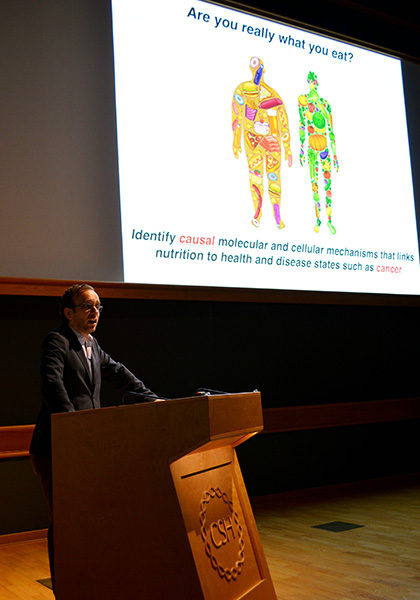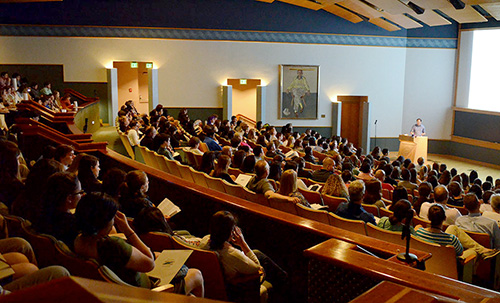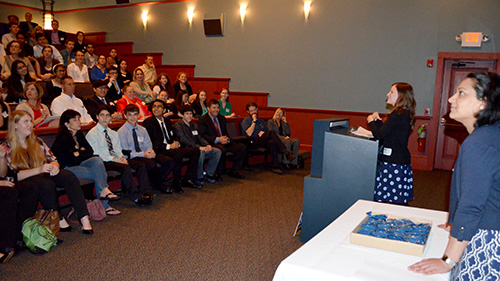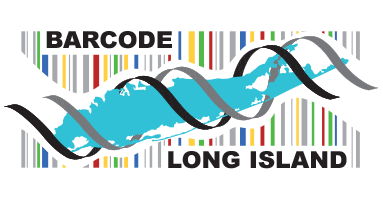Symposium: 2022 |2021 |2020 |2019 |2018 |2017 | 2016 | 2015
2022-23 Symposium
Thank you to all of the teams who submitted proposals, performed experiments, and will present project results at the poster sessions held at Cold Spring Harbor Laboratory on Tuesday, June 6, 2023 from 3:00-6:30 p.m.
At a glance:
- 173 students
- 26 teacher mentors
- 21 high Schools
60 DNA barcoding and metabarcoding projects:
- 62% animals
- 23% lichen
- 10% plants
- 3% fungi
- 2% microbiomes
Keynote Address
Deciphering the Dimensions of Lichen Diversity From Cities to Wilderness
James Lendemer, Ph.D.
Associate Curator at the New York Botanical Garden and
Adjunct Assistant Professor at the CUNY Graduate Center
2021-22 Symposium
Thank you to all of the teams who submitted proposals, performed experiments, and will present project results at the poster sessions held at Cold Spring Harbor Laboratory on Tuesday June 7, 2022 from 3:00-6:30 p.m.
At a glance:
- 138 students
- 18 mentors
- 17 high schools
45 DNA barcoding and metabarcoding projects:
- 56% animals
- 30% lichens
- 4% plants
- 4% algae
- 4% fungi
- 2% microbiomes
Keynote Address
Decoding Harmful Algal Blooms with Molecular Tools
Christopher J. Gobler, Ph.D.
Endowed Chair of Coastal Ecology and Conservation
School of Marine and Atmospheric Sciences
Director, New York State Center for Clean Water Technology
Stony Brook University
2020-21 Symposium
Thanks to all of the teams who submitted proposals, performed experiments, and presented project results at the Virtual Symposium on Wednesday, June 1, 2021.
At a glance:
- 102 students
- 14 mentors
- 17 high Schools
34 DNA barcoding and metabarcoding projects:
- 91% animals
- 3% plants
- 3% algae
- 3% microbiomes
Keynote Address
Understanding, deconstructing and rebuilding microbiomes to make a better world
Javier A. Izquierdo, Ph.D.
Associate Professor of Biology, Hofstra University
2019-20 Symposium
Thanks to all of the teams who submitted proposals, performed experiments, and presented project results at the Virtual Symposium on Wednesday, June 3 and June 4, 2020.
At a glance:
- 124 students
- 11 mentors<
- 11 high Schools
45 DNA barcoding and metabarcoding projects:
- 93% animals
- 7% microbiomes
Keynote Address
Wildlife detectives: The story of genome research, discovery, and exploration and the critical role of museum science
Rebecca Johnson, Ph.D.
Associate Director for Science and Chief Scientist
Smithsonian National Museum of Natural History
2018-19 Symposium
Thanks to all of the teams who submitted proposals, performed experiments, and presented project results at the poster sessions held at Cold Spring Harbor Laboratory on June 4, 2019. In addition to traditional DNA barcoding and microbiome projects, environmental DNA (eDNA) projects were introduced this year, allowing teams to study the species and approximate abundance of fish in local habitats from mixed water samples.
At a glance:
- 208 students
- 22 teacher mentors
- 25 high schools
79 DNA barcoding & metabarcoding projects:
- 75% animals
- 11% metabarcoding
- 5% plants
- 4% algae
- 4% fungi
- 1% lichens
Keynote Address

The Interplay Between Diet and Microbiome in Cancer Risk
Semir Beyaz, Ph.D.
CSHL Fellow and Donaldson Translational Fellow
Cold Spring Harbor Laboratory
2017-18 Symposium
Thanks to all of the teams who submitted proposals, performed experiments, and presented project results at the poster sessions held at Cold Spring Harbor Laboratory on June 5, 2018. This year the program expanded to include metabarcoding; student teams determined barcode sequences for microbes in a mixed sample to assess ecosystem response to environmental variables.
At a glance:
- 382 students
- 44 teacher mentors
- 39 high schools
133 DNA barcoding & microbiome projects:
- 83.5% animals
- 3.8% algae
- 3.0% plants
- 1.5% fungi
- 0.8% lichens
Keynote Address
DNA Barcoding as a Tool for Conservation Biology
George Amato, Ph.D.
Director of Conservation Genomics
Sackler Institute for Comparative Genomics
American Museum of Natural History
2016-17 Symposium
Thanks to all of the teams who submitted proposals, performed experiments, and presented project results at the poster sessions held at Cold Spring Harbor Laboratory on June 7, 2017. This year the program expanded to include metabarcoding; student teams determined barcode sequences for microbes in a mixed sample to assess ecosystem response to environmental variables.
At a glance:
- 312 students
- 33 teacher mentors
- 30 high schools
85 BLI projects:
>1400 sequences obtained
- 72% animals
- 18% plants
- 7% algae
- 2% fungi
- 1% lichens
21 microbiome projects:
11 billion nucleotides of microbial sequence
- 24% vectors for disease
- 19% soil
- 19% terrestrial invertebrates
- 19% water
- 9% plants
- 5% aquatic macroinvertebrates
- 5% biofouling
Keynote Address

Metabolic Insights from Species Diversity through DNA Barcoding
Jeremy Seto, Ph.D.
Assistant Professor
New York City College of Technology
The City University of New York
2015-16 Symposium
Thanks to all of the teams who submitted proposals, performed experiments, and presented project results at the poster sessions held at Cold Spring Harbor Laboratory on June 10, 2016.
At a glance:
- 327 students
- 35 teacher mentors
- 30 high schools
113 projects:
- 52% plants
- 37% animals
- 6% fungi
- 4% lichens
- 1% other
>1700 samples collected
>2000 sequences obtained
Welcome & Keynote Address
A Life in Science and Nature
Mark Stoeckle, Ph.D.
Senior Research Associate
Program for the Human Environment
The Rockefeller University
[00:00] Welcome: Sharon Pepenella
[04:50] Keynote address
2014-15 Symposium
Thanks to all of the teams who submitted proposals, performed experiments, and presented project results at the poster sessions held at Cold Spring Harbor Laboratory DNA Learning Center on June 5, 2015.

At a glance:
- 24 participating teams
- 61 students
- 13 high schools
- 50% plants
- 33% animals
- 13% lichens
- 4% fungi
Students collected and analyzed an average of 20 samples per team


